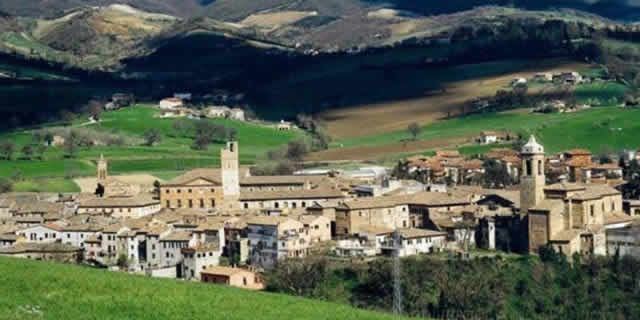Demonym(s) Matelicesi Area 81.04 km² Local time Wednesday 4:33 AM Postal code 62024 | Elevation 354 m (1,161 ft) Time zone CET (UTC+1) Dialling code 0737 | |
 | ||
Frazioni Balzani, Braccano, Castiglione, Cavalieri, Colferraio, Collepere, Colli, Grimaldi, Mistriano, Pezze, Piane, Poggeto, San Nicola, Terricoli, Valbona, Vinano Weather 6°C, Wind SE at 3 km/h, 57% Humidity | ||
Matelica is a comune (municipality) of the Province of Macerata in the Italian region of Marche. Located about 60 kilometres (37 mi) southwest of Ancona and 35 kilometres (22 mi) west of Macerata, it extends over an area of 81.04 square kilometres (31.29 sq mi) and has a population of 10,129 inhabitants (as of 31 December 2013).
Contents
- Map of 62024 Matelica Province of Macerata Italy
- Introduction
- Historical background
- Demography
- Churches
- Climate
- Curiosities
- References
Map of 62024 Matelica, Province of Macerata, Italy
Introduction
Matelica lies in an ample valley where the Braccano creek joins the Esino river, dominated by the town from an eastern ravine. The valley, roughly in the north–south direction, is delimited on the east and west sides by Apennines’ sub-ranges, whose highest peaks are respectively Mount Gemmo at 719 metres (2,359 ft) and Mount San Vicino at 1,479 metres (4,852 ft), compared to the 354 metres (1,161 ft) above sea-level of the city centre. The old part of town presents a relatively well-preserved urban structure dating largely from the Middle Ages, and is punctuated by several monumental palazzi and churches from different periods. The local Piersanti Museum hosts a rich collection of artworks. Matelica borders on the following municipalities: Apiro, Castelraimondo, Cerreto d'Esi, Esanatoglia, Fabriano, Fiuminata, Gagliole, Poggio San Vicino, San Severino Marche.
Historical background
The first human settlements in the area can be traced to the Umbri and Picentes and date back to the 1st millennium BC. Later, under Roman rule, Matelica became a municipium (70 BC). Starting from the 5th century AD, it was seat of a Bishop, who for a while remained the only authority, after the fall of the Roman Empire. The town was then annexed to the Byzantine Empire (552). Destroyed by Longobards in 578, it was subsequently joined to the bishopric of Camerino. From the 9th century, Matelica was under the indirect rule of the Holy Roman Empire (while belonging formally to the Papal States), then becoming a free municipality in 1160. In 1174, it was again obliterated, this time by the army of Christian I (Archbishop of Mainz). Since then, Matelica remained part of the Papal States (albeit at times under an independent Governor), until the Italian unification (1861), save for the brief Napoleonic occupation.
Demography
Over the last thirty years (1982–2012), the total population of Matelica has remained fairly constant at about 10,300, the decrease in the birth-rate being substantially compensated by the migration from within Italy or abroad and by a greater longevity. The demographic distribution reflects that of Italy, although with a relatively larger proportion of aged people, see the pyramid of population below.
Churches
Climate
The climate is dictated by the Apennines and, to a lesser extent, by the temperate Adriatic Sea on the east. Consequently, Matelica enjoys a continental climate with cold winters and hot, dry summers. In winter, sub-zero temperatures and snowfall between December and February are common. Highest summer temperatures can be well above 30 °C (86 °F) in June and August. In keeping with the layout of the valley, the dominant winds are along the north–south direction, those from the south being more frequent but weaker than those from the north.
